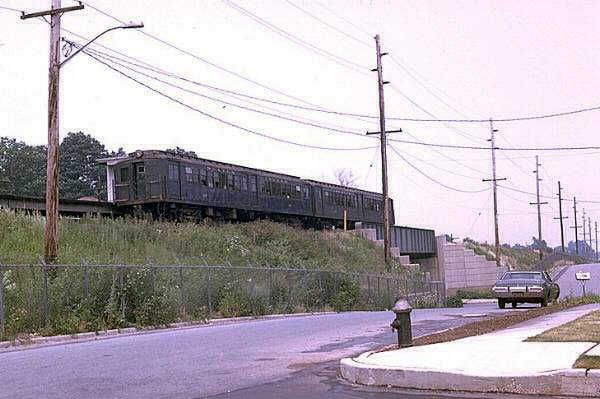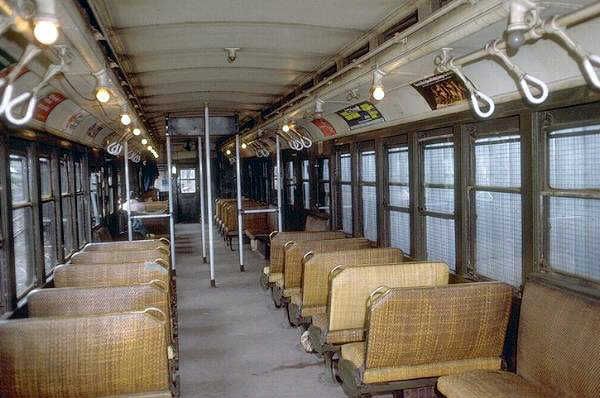
Sister cars on Staten Island on 07/19/1970 -Joseph Testagrose Collection at newdavesrailpuix.com
- Builder
- Standard Steel Car Co.
- Description
- Low-density rapid transit car
- Secondary Use
- Failed preservation
- Type
- Rapid Transit Cars
- Year
- 1925
- Retired from Service
- 1973
- Acquired by the Museum
- 1993
- Fund
- 862
- Sponsor/Manager
- None
Staten Island Rapid Transit 366
From New York, New York
History
The Staten Island Rapid Transit (SIRT) operated three lines in the New York City’s most suburban borough. SIRT was owned by the Baltimore & Ohio Railroad, which also owned and operated freight service on the island’s lines. Passenger service operated out of the terminal at St. George where passengers connected with ferries to Manhattan, while all freight entered the island via a drawbridge from New Jersey. Today freight service is confined to a container terminal near the bridge, and only the main passenger line, from St. George to Tottenville, remains. In the 1920s, the SIRT decided to convert its passenger service from steam to electric operation. For the new service, Standard Steel Car delivered 100 transit cars, including No. 366, to the SIRT in 1925. The fleet included 90 powered cars and 10 trailer cars. The cars used on the SIRT were 67 feet long and 10 feet wide, matching the equipment in use on New York’s BMT subway system. This was deliberate, since the city expected to build a tunnel from Brooklyn to Staten Island. However, the tunnel was never built. The SIRT cars had some distinctive features, such as headlights, pilots and handholds, which were necessary to operate along with steam freight trains. While the Standard Steel cars were a rapid transit design, SIRT’s operation retained characteristics of a steam railroad or an interurban. The route was semi-rural with numerous grade crossings, and fares were collected on board railroad fashion.
When bus competition caused ridership declines, SIRT sold 30 of its Standard Steel cars to the New York City Transportation Authority in 1953-54. The Metropolitan Transportation Authority acquired the SIRT in 1971. The MTA placed SIRT in a sub-authority, the Staten Island Rapid Transit Operating Authority (SIRTOA), to operate it. The New York City Transit Authority’s R-44 car order was extended to provide new cars for the island. The new cars entered service in 1973, and most of the old SIRT cars were scrapped.
After withdrawal from service in 1973, SIRTOA kept one old car at its Clifton shop as a work/storage car and preserved three more, including No. 366, for possible display at the Richmondtown Restoration (a Staten Island historic site). The Richmondtown plan did not occur, and SIRTOA kept the cars at various sites. In 1983-84, the Trolley Museum of New York acquired SIRTOA’s four 1925 cars. TMNY took one car, trailer car No. 508, to its museum site at Kingston, NY, but vandals later destroyed this car. TMNY stored No. 366 and the other two SIRT cars at the Consolidated Edison Arthur Kill generating station on Staten Island. In 1993, Seashore acquired No. 366 when the Trolley Museum of New York decided it lacked the resources to preserve the car. One other SIRT Standard Steel car was saved and was acquired by the Shore Line Trolley Museum (formerly Branford Trolley Museum). With the acquisition of No. 366, Seashore owns vehicles that operated in all five boroughs of New York City.
Technical Information
- Seats: 71
- Control: PC-10L
- Brakes: AMUE
- Compressor: D-3-F
Trucks
- Number: 2
Motor
- Number: 2
- Manufacturer: General Electric
- Model: 282
Weight and Dimensions
- Length: 67’ 8.00"
- Width: 10’
- Height: 12’ 2.00"
- Weight: 98000 lbs.
Additional Images

Sister car #393 car interior on 04/081973

Sister car #393 car interior on 04/081973
© 1998 - 2025 New England Electric Railway Historical Society. All Rights Reserved.